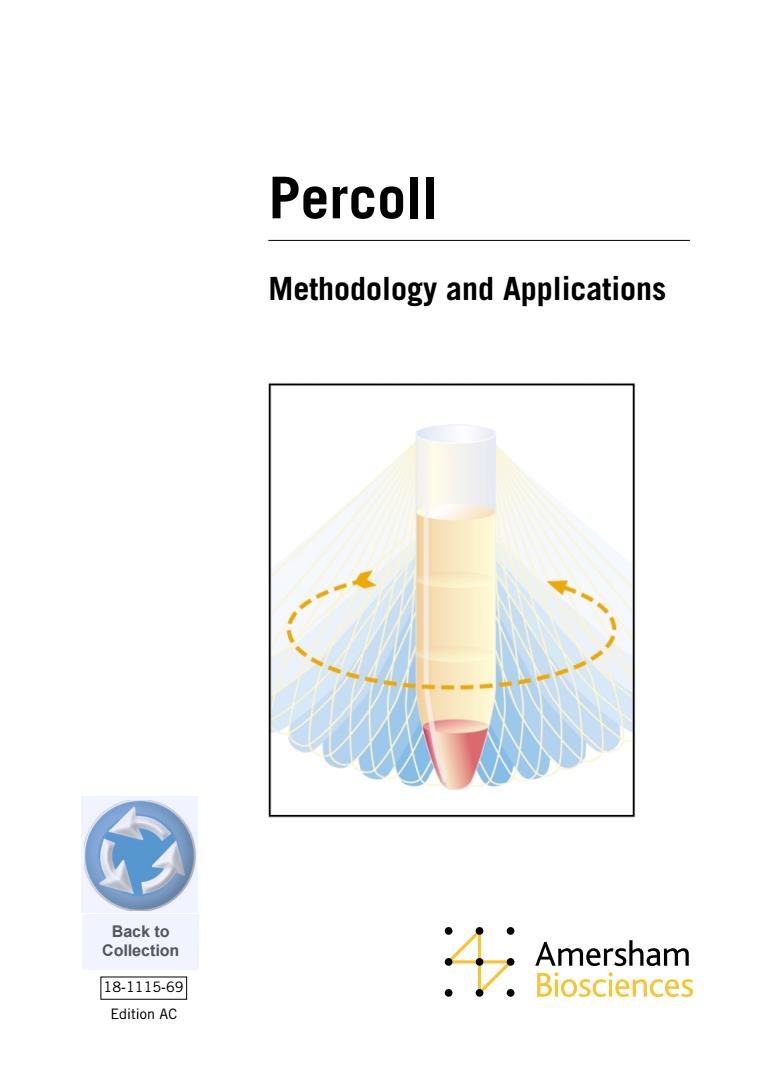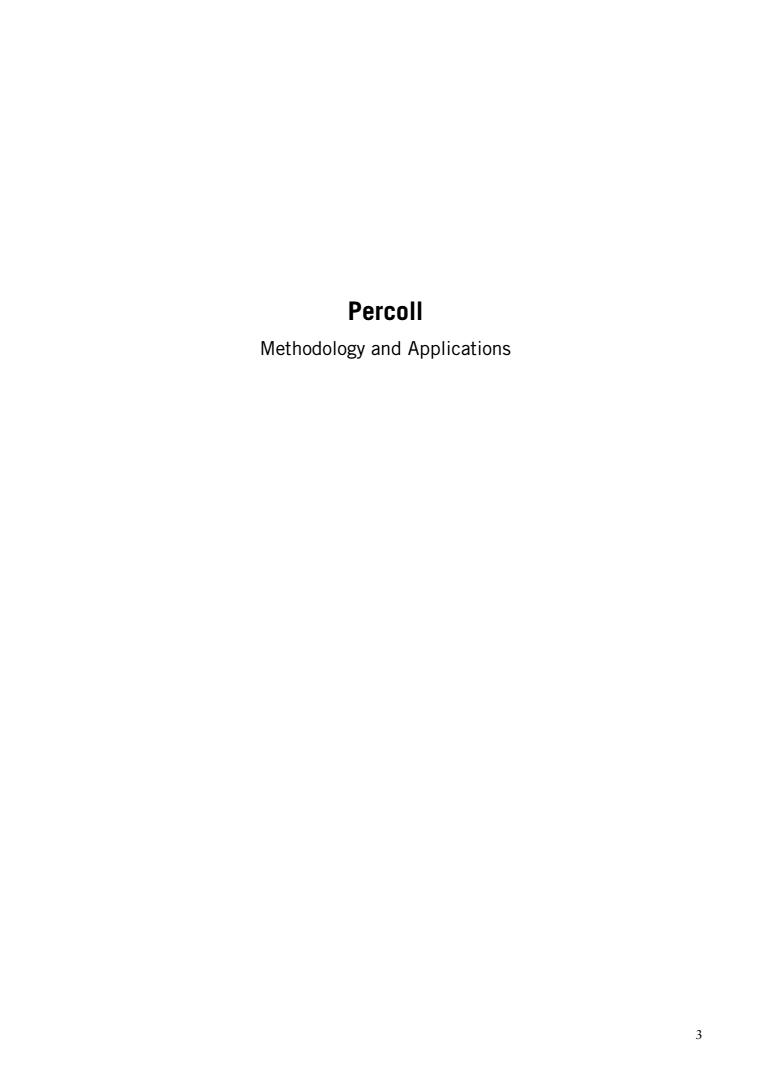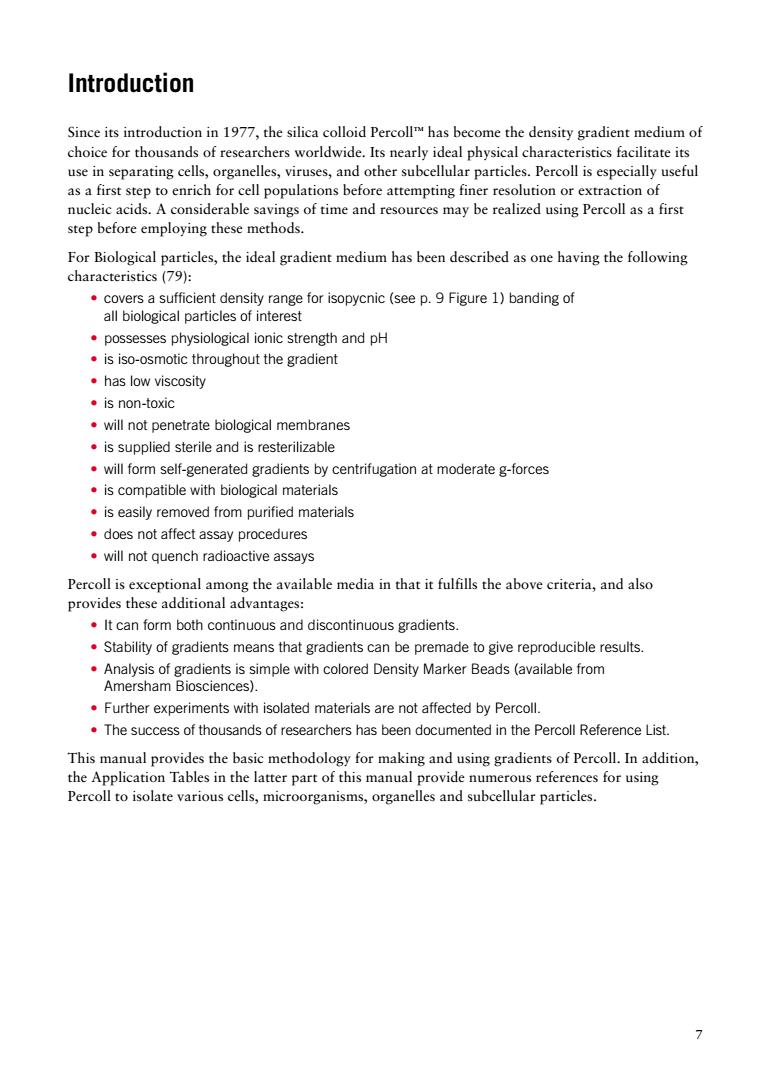
Percoll Methodology and Applications Back to Collection Amersham 18-1115-69 Biosciences Edition AC
1 18-1115-69 Edition AC Percoll Methodology and Applications

Percoll Methodology and Applications
3 Percoll Methodology and Applications

Content Introduction 7 Principles of density gradient centrifugation .8 Separation by density(lsopycnic centrifugation) Separation by size (Rate) Percoll-physical properties. .10 Particle size Sity Density. 10 pH and osmolality. .11 Behavior of the colloid. .11 How to make and use gradients of Percoll 12 Making and diluting a stock solution of Percoll 12 Diluting stock solutions to lower densities. .12 14 **4040 15 Effects of osmolality on apparent buoyant density of cells and subcellular particles. 17 Factors affecting gradient formation and shape. .18 Discontinuous gradients. .20 Continuous linear and non-linear gradients 20 Preformed self-generated gradients. 21 Gradients formed in sit 3 Maximum sample loading 22 A model experiment to standardize conditions 22 How to fractionate and analyze gradients of Percoll 23 Density determination using Density Marker Beads Using Density Marker Beads. 25 Other methods for measuring density. 25 Fractionation of gradients Cell sorting and counting 26 Protein determination and enzyme assay. Removal of Percoll after centrifugation 27 Washing 27 2 Other methods
4 Content Introduction . 7 Principles of density gradient centrifugation . 8 Separation by density (Isopycnic centrifugation) . 9 Separation by size (Rate zonal centrifugation) . 9 Percoll - physical properties . 10 Particle size composition . 10 Viscosity . 10 Density . 10 pH and osmolality . 11 Behavior of the colloid . 11 How to make and use gradients of Percoll . 12 Making and diluting a stock solution of Percoll . 12 Diluting stock solutions to lower densities . 12 The one-step procedure for diluting Percoll . 14 Diluting Percoll to a desired osmolality . 15 Effects of osmolality on apparent buoyant density of cells and subcellular particles . 17 Factors affecting gradient formation and shape. 18 Discontinuous gradients . 20 Continuous linear and non-linear gradients . 20 Preformed self-generated gradients . 21 Gradients formed in situ . 21 Maximum sample loading . 22 A model experiment to standardize conditions . 22 How to fractionate and analyze gradients of Percoll . 23 Density determination using Density Marker Beads . 23 Density Marker Beads - properties . 23 Effects of ionic strength and sucrose concentration on density of Density Marker Beads . 24 Using Density Marker Beads . 25 Other methods for measuring density . 25 Fractionation of gradients . 26 Cell sorting and counting. 26 Protein determination and enzyme assay . 26 Removal of Percoll after centrifugation . 27 Washing . 27 High speed centrifugation . 27 Other methods . 28

Practical notes Care and cleaning of equipment. Aggregates of silica particles. .29 Applications 30 Blood cells . 30 Applications-Blood Cells. Applications-Other Cell Types 38 Applications-Microorganisms. A6 Applications-Subcellular Particles. .48 Appendix 1-Summary methodology charts References. .56 Ordering Information. Culture. Products for Purification of DNA 81 Kits for cDNA Synthesis. .81
5 Practical notes . 29 Care and cleaning of equipment . 29 Storage of Percoll . 29 Sterilization of Percoll solutions . 29 Aggregates of silica particles. 29 Applications . 30 Blood cells . 30 Applications - Blood Cells. 31 Applications - Other Cell Types . 38 Applications - Microorganisms . 46 Applications - Subcellular Particles . 48 Appendix 1 - Summary methodology charts . 54 Scheme 1. Separation of cells on gradients of Percoll . 54 Scheme 2. Separation of subcellular particles on gradients of Percoll . 55 References. 56 Ordering Information. 80 Products for Cell Separation and Culture . 80 Products for Purification of RNA . 81 Products for Purification of DNA . 81 Kits for cDNA Synthesis . 81

Introduction Since its introduction in 1977,the silica colloid Percoll has become the density gradient medium of choice for thousands of researchers worldwide.Its nearly ideal physical characteristics facilitate its use in separating cells,organelles,viruses,and other subcellular particles.Percoll is especially useful as a first step to enrich for cell populations before attempting finer resolution or extraction of nucleic acids.A considerable savings of time and resources may be realized using Percoll as a first step before employing these methods. For Biological particles,the ideal gradient medium has been described as one having the following characteristics (79): .possesses physiological ionic strength and pH is iso-osmotic throughout the gradient ·has low viscosity ·is non-toxic will not penetrate biological membranes is supplied sterile and is resterilizable will form self-generated gradients by centrifugation at moderate g-forces .is compatible with biological materials .is easily removed from purified materials does not affect assay procedures will not quench radioactive assays Percoll is exceptional among the available media in that it fulfills the above criteria,and also provides these additional advantages .It can form both continuous and discontinuous gradients. .Stability of gradients means that gradients can be premade to give reproducible results. Aag2esnpewahcoe0eayweeeataabetom .Further experiments with isolated materials are not affected by Percoll. .The success of thousands of researchers has been documented in the Percoll Reference List. This manual provides the basic methodology for making and using gradients of Percoll.In addition, n Tables in the lat s for using eppoucells,microorganisms,organelle and subcelular partce refe
7 Introduction Since its introduction in 1977, the silica colloid Percoll™ has become the density gradient medium of choice for thousands of researchers worldwide. Its nearly ideal physical characteristics facilitate its use in separating cells, organelles, viruses, and other subcellular particles. Percoll is especially useful as a first step to enrich for cell populations before attempting finer resolution or extraction of nucleic acids. A considerable savings of time and resources may be realized using Percoll as a first step before employing these methods. For Biological particles, the ideal gradient medium has been described as one having the following characteristics (79): • covers a sufficient density range for isopycnic (see p. 9 Figure 1) banding of all biological particles of interest • possesses physiological ionic strength and pH • is iso-osmotic throughout the gradient • has low viscosity • is non-toxic • will not penetrate biological membranes • is supplied sterile and is resterilizable • will form self-generated gradients by centrifugation at moderate g-forces • is compatible with biological materials • is easily removed from purified materials • does not affect assay procedures • will not quench radioactive assays Percoll is exceptional among the available media in that it fulfills the above criteria, and also provides these additional advantages: • It can form both continuous and discontinuous gradients. • Stability of gradients means that gradients can be premade to give reproducible results. • Analysis of gradients is simple with colored Density Marker Beads (available from Amersham Biosciences). • Further experiments with isolated materials are not affected by Percoll. • The success of thousands of researchers has been documented in the Percoll Reference List. This manual provides the basic methodology for making and using gradients of Percoll. In addition, the Application Tables in the latter part of this manual provide numerous references for using Percoll to isolate various cells, microorganisms, organelles and subcellular particles